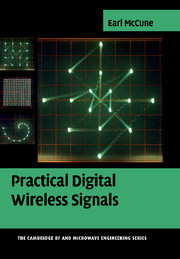Book contents
- Frontmatter
- Contents
- Preface
- Definitions and acronyms
- Terminology and notation
- 1 Keying, states, and block diagram construction
- 2 Common issues and signal characterization
- 3 Important details on results from Shannon, Nyquist, and others
- 4 Digital amplitude modulation (ASK)
- 5 Digital frequency modulation: FSK
- 6 Digital phase modulation: PSK
- 7 Combined digital modulations: QAM and OFDM
- 8 Spread spectrum
- 9 Wireless propagation and antenna fundamentals
- 10 Principles of coding
- 11 Multiple access techniques
- 12 Signal tradeoffs and system evolution
- Tutorial Appendices
- Index
- References
9 - Wireless propagation and antenna fundamentals
Published online by Cambridge University Press: 04 August 2010
- Frontmatter
- Contents
- Preface
- Definitions and acronyms
- Terminology and notation
- 1 Keying, states, and block diagram construction
- 2 Common issues and signal characterization
- 3 Important details on results from Shannon, Nyquist, and others
- 4 Digital amplitude modulation (ASK)
- 5 Digital frequency modulation: FSK
- 6 Digital phase modulation: PSK
- 7 Combined digital modulations: QAM and OFDM
- 8 Spread spectrum
- 9 Wireless propagation and antenna fundamentals
- 10 Principles of coding
- 11 Multiple access techniques
- 12 Signal tradeoffs and system evolution
- Tutorial Appendices
- Index
- References
Summary
No discussion of wireless communication is complete without some discussion on the propagation of wireless signals. Indeed, propagation is the “wireless” part of wireless communication!
Much of the difficulty involved in successful wireless communication results from effects encountered while the signal is propagating from the transmitter to the receiver. This chapter introduces the major effects encountered during propagation, and how they manifest themselves as characteristics on the received signal. Chapter 10 presents the principles of how DWC engineers clean up this messy received signal and still get good quality communication from the DWC link through the use of coding.
Electromagnetic wave existence and propagation was first worked out mathematically before it was physically measured. This brilliant mathematical work was done by James Clerk Maxwell and published in 1873. Maxwell was interested in combining the known relationships among electric fields (sparks) from Gauss, Faraday, and Volta, with magnetism worked out by Ampère (plus many others). What Maxwell discovered is that the combined equations he worked out had a solution which was a propagating wave. He recognized that this result also applied to light, and that the propagating velocity from his equations was an expression for the speed of light.
About 15 years later, a researcher named Heinrich Hertz decided to try and confirm the existence of the predicted electromagnetic waves from Maxwell. He succeeded, not only proving that electromagnetic waves exist and can be intentionally generated and detected, but that they exhibit polarization (also predicted by Maxwell).
- Type
- Chapter
- Information
- Practical Digital Wireless Signals , pp. 248 - 269Publisher: Cambridge University PressPrint publication year: 2010



